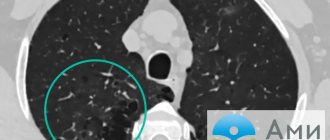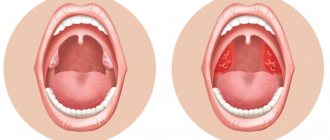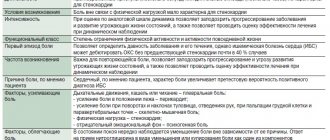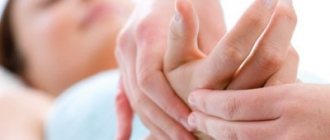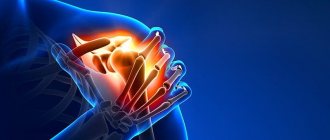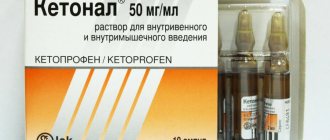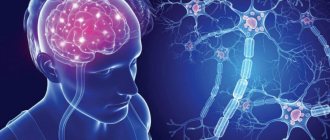Myofascial syndrome. Fragment of Dr. Vlasenko’s interview with the Neuromir-TV channel
There is an expression: “The spine is the key to health.” We won’t deny this, but we shouldn’t hold the spine responsible for all back pain either. After all, anatomically, the back also consists of ribs, shoulder blades, various ligaments and many muscles. And even without the help of the spine, they are capable of causing truly hellish torment, which can really be mistaken for symptoms of a herniated disc or radicular syndrome.
Take muscle spasms, for example. It is believed that muscles make up about 45% of our body. Therefore, it is not surprising that muscle spasms can occur literally anywhere and at the same time cause severe pain. By the way, any woman who has given birth will confirm this. After all, pain and contractions during childbirth are nothing more than a spasm of the muscles of the uterus. The uterus consists of muscles that are the strongest in a woman's body. Another striking example of muscle pain is muscle tension headache. Here, as you can see, already in the name itself there is an indication of the cause of pain - muscle tension.
I give these examples only so that you, dear reader, take a look at the question “Why does my back hurt?” from a new point of view. Although, in fact, there is nothing new in it, you just might not have known before that the culprits of back pain are most often not displaced vertebrae and discs, but muscle spasms. And to be completely precise - spasms of individual fibers in the muscles of the back, neck or lower back. By the way, this is convincingly evidenced by both statistical data and modern scientific research.
“What about osteochondrosis and disc herniation?” - you ask. And no one canceled them. Only the role of osteochondrosis and hernias in the occurrence of pain is greatly exaggerated. There is convincing evidence of this. See for yourself:
If the patient complains of back pain, an MRI is performed and osteochondrosis or disc herniation is detected. The patient is treated and the pain goes away. But, if you do a second MRI, it turns out that both osteochondrosis and the disc herniation remain in the same place. So why did my back hurt? The explanation for this is quite simple - they were not the culprits of the pain. And if we look at the statistics again, we find out that the cause of back pain in 75–85% of cases is muscle spasms. And a hernia and osteochondrosis may be present, but never bother a person!
Muscle pain. What is myofascial syndrome?
Let's start with the word "syndrome". It is almost synonymous with the word “disease.” The only difference is that the symptoms of the disease have a common mechanism of development and a common origin. But the symptoms that make up the syndrome have only a common development mechanism, and their origin is different. It's easier to understand with an example. All symptoms of salmonellosis have a common origin - they are caused by Salmonella bacteria. Therefore, salmonellosis is a disease. But the symptoms of myofascial syndrome have different origins: impaired neuromuscular conduction, overload, fatigue, stress, metabolic disorders, sedentary lifestyle, bad habits, injuries, etc. That is why myofascial syndrome is called “syndrome”.
Now - “myofascial”. This word consists of two words: “myo” - muscle and “fascia” - the muscular sheath that covers every muscle in our body. Muscles and fascia are inseparable from each other: they work together and get sick together. And they should also be treated together. Let’s agree right away: for simplicity, we will not say “muscles and fascia,” but simply “muscles.” But, in fairness, let’s start with the fascia.
Fascia is a muscular sheath that sometimes shortens, similar to how clothes shrink when washed improperly. This happens for various reasons, for example, from a sedentary lifestyle or from injury. As a result of such shortening, the fascial sheath becomes tight, it compresses the muscle - and the muscle, under the influence of this tightness, has to reflexively contract. As soon as muscle compression reaches a certain force, the muscle automatically pinches the nerve endings, veins and arteries that pass through it. But the most important thing is that the tightened muscle can no longer contract normally. Consequently, the tight muscle will work worse and weaken.
This pathological process is called musculofascial shortening . Under the onslaught of this pathology, the body will adapt to increasing pathological changes and maintain independent defense as long as it has enough strength. All this time, healthy muscles will take on the load, compensating for all the shortcomings. However, even healthy muscles will not be able to withstand the overload indefinitely, so they will also begin to weaken and shrink. Thus, the pathological process, spreading from one muscle to another, will gradually cover the entire musculature of the back and limbs. First, this will change your posture, then it will overload the spine, leading to the formation of intervertebral hernias and protrusions. And finally, having exhausted the possibility of compensation, the body will give “SOS” signals - the occurrence of pain. This is what myofascial syndrome looks like.
We are used to thinking that pain occurs because a person lifted a heavy object, “rested” his neck, or sharply bent over. But that's not true. The listed circumstances only transfer the disease into the open phase.
Common mistakes when treating back pain
Many people, when they first feel pain in the back or in another part of the body, make desperate attempts to “treat” it with exercises. This happens under the influence of the prevailing opinion about “pumping up” the muscle corset. This point of view is rather naive. It does not take into account that a sore muscle requires treatment, not stress. It wouldn’t occur to anyone to treat pain at the time of a sprained or broken leg by running - “limp, but run.”
Treatment and rehabilitation should not be confused. The difference between these two concepts is huge. Treatment is the fight against the disease, and rehabilitation is making up for lost time while the person was sick. Replacing the treatment process with rehabilitation is a very short-sighted step. After all, rehabilitation exercises are not just physical education. They are called restorative precisely because they should be performed at the last - restorative stage of treatment, after the disease has subsided. But under no circumstances during acute or subacute periods, when the disease is at its peak! Otherwise, there is a great danger of overstraining the body’s compensatory forces, which are already at their limit.
Another common misconception is the “repositioning” of vertebrae. An inexperienced patient encountering back pain for the first time most often expects that everything will be “quickly corrected” for him and that will be the end of the matter. How far from the truth he is! After all, by the time pain appears, the balance between most muscles has already been disturbed. And if you compare the spine and muscles with the mast and ropes, it becomes clear that unevenly and asymmetrically tensioned ropes can easily warp the mast.
Usually, when examining patients, the asymmetry of many muscles is clearly visible. For example, the left muscle groups pull on the right ones, the front muscles are more tense than the back ones, and the deep ones are more tense than the superficial ones. It is as a result of this that our “mast” becomes warped. Therefore, if we limit ourselves to “repositioning” the vertebrae without properly relaxing the muscles, then the tense back muscles will “displace” the vertebrae again and again. Therefore, first of all, it is necessary to return the muscles to their normal state, freeing them from tension. And only then “straighten” the vertebrae and “pump up” the muscle corset. But most often, after the muscles relax, the vertebrae themselves “fall” into place, receiving the long-awaited freedom.
ethnoscience
Traditional medicine for this disease is exclusively symptomatic. It relieves only pain and spasms, and only temporarily. But it never cures the pathology itself. In order to obtain lasting results, it is necessary to use drugs and physical treatment methods for TT.
Important! If it is impossible to take medications, and also in order to further relieve pain symptoms, you can use folk recipes that bring some benefit due to insulation.
Paraffin wraps . Melt the paraffin until it becomes liquid. Apply two layers to the sore spot. Cover this very place with film, then wrap it warmly for thirty minutes.
"Salt" compress. Heat the coarse salt until it becomes hot, but not so hot that it is unbearable. Apply to the location of pain. Cover with a blanket. Once it cools down, you can remove it. After this, draw a mesh on the skin with iodine. Apply a pepper patch over it. Then the patient should go to bed until the morning.
Using traditional medicine recipes will speed up the healing process
Sodium sulfate . It is also called magnesia, Epsom salt. This drug is sold in pharmacies. It can be used to relieve muscle spasms and pain. This can be done by taking a salt bath. Warm water itself makes the pain less painful. However, sodium sulfate also relieves tension, which is due to the fact that it contains magnesium, and this element seems to be specially created by nature in order to relax tense muscles. For the effect, it is enough to dissolve a glass or two of magnesia in the bath, and then lie in such water for a quarter of an hour.
However, heat is not the only factor that helps relieve MFBS. This is also facilitated by massage using essential oils. It can also be done at home. You can relieve muscle spasms with a massage with the following plant oils taken equally:
- mint;
- lemongrass;
- marjoram.
To relieve or ease pain, you can use the following oils during massage:
- immortelle;
- chamomile;
- lavender;
- basil.
In this case, it is recommended to mix the oils with each other, adding them to any base oil. Moreover, the best option for base oil is coconut .
For herbal therapy during MFBS, horsetail . This plant is an ingredient for ointment. During the cooking process, the herb is crushed and mixed with butter at the rate of one part herb to two parts butter.
A tincture is also made from the flowers of sweet clover .
Symptoms of myofascial syndrome
It happens that different diseases have similar symptoms, for example, pain. Speaking about myofascial syndrome, we do not forget that there are disc herniations, osteochondrosis and other diseases. After all, it often happens that a person has two or three diseases at the same time, and in different stages. For example, inactive disc herniation and exacerbation of myofascial syndrome. Therefore, it is important to distinguish what exactly is bothering the patient at the moment. Therefore, in order to truly cure a disease, it must first be recognized among the jumble of active and inactive symptoms.
Symptoms of myofascial syndrome are:
- trigger points;
- areas of referred pain;
- numerous vegetative disorders.
Now let's look at each of them separately.
Stages of disease development
The development of the disease, its course, as a rule, goes through three stages:
- Due to a number of reasons, active pain points appear. The muscles begin to contract involuntarily. There is severe pain that appears and disappears randomly.
- At the second stage, pain occurs only at the moment of impact on the affected muscle. When the muscles are at rest, there is no trigger activity.
- It becomes unimaginably difficult to move, because... the disease becomes chronic. The affected area may hurt during exposure to it, or may be in a calm state. It is impossible to understand when new spasms may occur.
Trigger points
Myofascial syndrome originates in the thickness of the muscles with microscopically small muscle spasms. Gradually, the spasm zone reaches a size that is significant for the microcosm. The number of such areas increases, they become denser and become incredibly painful. They are called trigger points - from the English word “trigger”, which in this case denotes the mechanism that triggers myofascial pain syndrome.
Please note that trigger points are a specific symptom inherent only(!) to myofascial syndrome. Trigger points fundamentally distinguish myofascial syndrome from all other diseases: osteochondrosis, disc herniation, etc.
Treatment of trigger points at the Spina Zdorova clinic is carried out according to the American method of gentle manual therapy, described in the book by Travel and Simons “Myofascial pain and dysfunction.”
If you accidentally discover similar painful points in different parts of your body, then the likelihood of myofascial syndrome is very high. But two other symptoms will help to make sure of this.
Areas of referred pain
Referred pain is like a sunbeam falling on a wall. Although the wall glows, any adult understands that it is just a reflection of the sun. Likewise, reflected pain is felt far from the place where its true source is hidden. Referred pain can manifest itself in different ways: both independently and simultaneously with pain at the trigger point itself.
It is impossible to catch the sunny “bunny” until you cover the mirror. Referred pain cannot be eliminated if you do not know where its true source is. The great success is that each trigger point has its own strictly defined “pattern” of the pain zone - a pain pattern. This correspondence allows the chiropractor to accurately find the true sources of pain and effectively eliminate them.
How to recognize?
The main symptoms of MFPS are as follows:
- the affected area hurts;
- movements are limited;
- a thick compaction has formed in the muscle;
- TT formed;
- a zone of reflected pain appeared, for each muscle.
Important! The first symptoms of cervical MFPS are also pain in the neck or back of the head or even throughout the head, face, even forearms.
Further pain is complemented by vegetative-vascular problems:
- dizzy;
- vision and hearing are impaired;
- ringing in the ears appears;
- the patient begins to faint.
A runny nose “out of the blue” and increased salivation are also possible.
Autonomic dysfunction
All processes that support both the life of the organism and its work are called vegetative. This includes breathing, nutrition and excretion, sleep and wakefulness, heating the body in the cold and cooling in the heat, and much more. Any disruption of these processes is usually called autonomic dysfunction.
In simple cases of myofascial syndrome, autonomic dysfunction is subtle. It is manifested by swelling of the sore spot, change in skin color or impaired sweating. But when myofascial syndrome is expressed strongly or for a long time, then autonomic dysfunction acquires very striking features. Morning stiffness, dizziness, nausea, sometimes vomiting, stuffy ears, a lump in the throat and anxiety appear. General weakness, fatigue, irritability, depression, bad mood and tearfulness, insomnia at night and drowsiness during the day, absent-mindedness and memory loss occur. Disturbances in the functioning of internal organs are common: abdominal pain, palpitations, lack of air. Headaches, feeling of squeezing of the head, torso or limbs.
However, patients associate all of the listed autonomic disorders with anything, but not with muscles. Therefore, people turn to a chiropractor as a last resort, thereby allowing the disease to spread its influence.
OUR DOCTORS:
| Lopatko Dmitry Nikolaevich | Neurologist, chiropractor, hirudotherapist, reflexologist, kinesiologist Neurologist of the highest category. Proficient in treatment methods in the following areas: manual therapy, applied kinesiology, osteopathy, homeopathy, reflexology. He successfully applies his knowledge in the treatment of pain syndromes associated with diseases of the musculoskeletal system, pathology of internal organs and psycho-emotional disorders. He has his own experience in the treatment and diagnosis of neurodental diseases. Author of patent for invention No. 2010153976 / 14 – (078049) “Method of therapeutic effects of transcranial magnetic stimulation for prosopalgia.” A specialist with more than 25 years of experience. Took training and master classes with prof. Vasilyeva L.F. Joseph, Shafer, Christopher Smith, David Leaf, Jose Palomar. |
| Zhimolostnov Andrey Vasilievich | Physiotherapist, shock wave therapy specialist, chiropractor, podiatrist (specialist in the manufacture of custom insoles) Provides treatment and prevention of diseases of the musculoskeletal system, chronic diseases of the ENT organs, and many others using various physiotherapeutic methods. Graduated from Krasnoyarsk State Medical Institute, internship. He completed advanced training in “Endoscopy in Pediatrics” at the Novokuznetsk State Institute for Advanced Training of Physicians. Also completed the courses “Children’s Infectious Diseases”, “Current Issues in Pediatrics”, “Neonatology”, “Pulmonology in Pediatrics”, “Doctor of Rehabilitation Medicine”, Krasnoyarsk State Medical University, “Physiotherapy”, at the State Scientific Center of the Russian Federation - Federal Medical Biophysical Center named after A.I. Burnazyan. Works with patients of all ages. |
Causes of muscle pain. What are the causes of myofascial syndrome?
Lifting weights, hypothermia, negative emotions. What connects all these factors and muscle pain?
Acute muscle overload
.
As a rule, if back pain occurs due to lifting, bending, awkward movement or injury, then it does not raise questions, its causes are so obvious. There is also chronic muscle overload
, and it occurs due to scoliosis, poor posture or monotonous posture, for example, with a sedentary lifestyle. However, we will discuss chronic muscle overload, due to its dominant pathological effect on the body, separately.
Metabolic disorders
. This includes overweight, hormonal deficiency, anemia, low levels of hemoglobin, vitamins, calcium, sodium and iron. In addition, various toxins have a fatal effect on metabolic processes: from viral and microbial (remember the muscle aches in the body during a cold), ending with the toxic products of smoking, alcohol or drugs. In general, any intoxication seriously disrupts the nutrition of muscle cells, leading to overexertion and the development of myofascial syndrome.
Another cause of pain is hypothermia
. It is the muscles that produce heat in the body. It’s not without reason that when actively moving, a person becomes hot, and when frozen, he shivers from the cold. Shivering is the extremely intense work of muscles to produce heat. Severe hypothermia can cause overload, leading to pathological tension and painful myofascial syndrome.
Emotional disturbances.
Let's focus on this reason. Do you know why? Because most people are not aware of the connection between emotions and muscles, and this connection is so significant that it cannot be neglected! And since we are talking about emotional stress, we need to understand that in a big city, even the most conflict-free and healthy lifestyle is associated with mental depression. Artificial light, street noise, lack of sleep and other factors in the metropolis catastrophically overload the sympathetic system, which serves as a starter for muscle overstrain. Emotional overload is a significant and very significant reason that increases pathological muscle tension - take this into account when analyzing your pain.
And finally, let’s name the most common, and perhaps the main cause of myofascial syndrome. It's called muscle imbalance
.
Diagnostics
Palpation is the gold standard in determining the presence of an area of muscle tension. This involves training and developing the precise skills of specialists to identify these stress areas.
Palpation of tension areas requires precise knowledge of muscle anatomy, the direction of specific muscle fibers, and muscle function.
Muscle palpation must meet several basic criteria and supporting observations to identify the presence of trigger points.
Main criteria
- Tension zone (where muscles are accessible).
- Presence of a place of pain in the tension zone.
- Reproduction of symptoms upon palpation.
- Pain occurs when a muscle is stretched (limited range of motion).
Supporting Observations
- Visual or tactile response to local twitching.
- The patient reports pain when pressing in the tension area.
- SEA was confirmed by electromyography.
Over the past few years, the reliability of palpation has been the subject of scientific debate. Recent studies have seen improvements in methodological quality, but the main problem is the lack of blinding. This is a problem that is difficult to solve because the reliability of palpation depends on the level of competence of the specialist.
Recent studies have shown interesting results using magnetic resonance elastography. The technique involves injecting cyclic waves into the muscle and then using phase contrast imaging to identify tissue distortions. Wave speed is determined from graphic images. Shear waves travel faster in stiffer tissues. And then the tension zone can be distinguished from the surrounding normal muscles.
Another recent method used to confirm dilatation of MPTT areas is sonoelastography combined with Doppler imaging.
It uses a clinical ultrasound imaging system with a linear resolution of 12-5 MHz coupled to an external vibration source (handheld vibration massager) operating in cycles of approximately 92 Hz. Doppler imaging is used to identify surrounding blood flows.
Ballyns et al showed that sonoelastography can be a useful tool for classifying MPTT into regions. Larger areas correspond to active trigger points, and smaller areas correspond to latent trigger points.
It is noted that this method requires preliminary manual palpation of trigger points.
Muscle imbalance. Chronic muscle overload is the main danger
What is muscle imbalance? The balance between which muscles is disturbed with it? There is an opinion that muscle imbalance is a violation between the so-called opposing antagonist muscles, that is, flexor and extensor, anterior and posterior, deep and superficial. But in reality, muscle imbalance is an imbalance between the phasic and tonic muscles.
According to their functions, the muscles of our body are divided into two groups. Some perform a movement and are called motor, dynamic, or phasic. Others hold the pose, counteracting the gravitational forces of the earth's attraction and the pressure of the atmosphere on us. These muscles are called postural-tonic, tonic, or postural. During movement, all muscle groups work. For example, when walking, the motor muscles “go”, and the postural-tonic muscles keep the body vertical. Therefore, the workload of both groups is distributed evenly and balanced. When a person is motionless, for example, sitting, then only his tonic muscles work, and his motor muscles are inactive.
The life of a modern person is deprived of movement. Today, since childhood, static and monotonous poses have prevailed. And if we add to this poor posture and scoliosis, which in themselves are a static overload, then the scale of the problem becomes obvious. Static monotony forms a fatigue overstrain of the tonic muscles, which causes them to shrink and become “woody,” while the motor muscles, on the contrary, become decrepit from prolonged inactivity.
It is this ratio, when the tonic muscles are overloaded with work, and the motor muscles are relaxed from idleness, that is usually called muscle imbalance.
Sooner or later, muscle imbalance leads to the appearance of local muscle spasms. Having begun due to chronic muscle overload, spasms intensify under the influence of “second-order” causes. What aggravates the problem is that a person cannot feel muscle imbalance, unlike injury, heaviness or hypothermia. The invisibility of the initial stage of the disease allows it to take deep roots and spread its sprouts everywhere.
Effective treatment for muscle pain. Manual treatment of myofascial pain syndrome
How to restore lost balance to muscles? This task, although difficult, is quite realistic. Manual treatment and moderate physical activity will provide them with a full and high-quality recovery. And it doesn’t matter what you do: swimming, Pilates, exercise machines or physical therapy, the main thing is that the sports load does not exceed your physical fitness and is performed at the appropriate time.
Note! The cause of 90% of back pain is myofascial syndrome.
For any disease, there are basic, auxiliary and restorative treatment methods. You can’t do without the main ones, the auxiliary ones enhance the effect of the main ones, and the restorative ones help restore the body. Purely theoretically, the best result will be obtained by a simultaneous combination of all effects, but in practice this will result in either very troublesome or unreasonably expensive treatment. Therefore, the most rational choice remains the main method, supplemented, if possible, by auxiliary ones. And here the question arises, what method of treatment of myofascial syndrome should be considered the main one? To understand this, we will give a brief description of the most common methods.
Drug treatment. When a painful attack occurs, it can grow like an avalanche, activating more and more new trigger points. Therefore, if you do not have a better option now, then by all means take the medicine. The most commonly used drugs are analgesics, non-steroidal anti-inflammatory drugs (NSAIDs) and muscle relaxants. Remember, as an axiom, pain cannot be tolerated.
Some people ignore any pill because of possible side effects. But no medicine in the world can compare with the “side effects” of pain. Because even minor but constant pain is a stress factor. It seriously depletes and suppresses the nervous system. It may seem surprising, but the word “depression”, in Latin “depressio”, means real depression. In other words, even mild but prolonged pain gradually suppresses the nervous system, forming somatoform depressive states, the inevitable consequence of which is the consolidation and fixation of the pain itself. A vicious circle is created: muscle tension - pain - muscle tension.
The disadvantages of drug treatment for myofascial syndrome are that it cannot be used for a long time. Therefore, with pronounced, widespread and prolonged muscle tension, the final effectiveness of medications is low; they simply do not have enough time and power to free the muscles from tension and overcome the disease.
Acupuncture. It’s a good way to relax your muscles, but finding an intelligent specialist is a rare success; there are only a few of them. Therefore, most often the cost of acupuncture exceeds its effectiveness. Health is not something that can be frivolously experimented with using extravagant treatments, especially when there are correct and affordable solutions. This is my opinion.
Physiotherapy for pain and therapeutic exercises for pain are auxiliary types of treatment. At the right moment, they fully justify the tasks assigned to them. However, if physical therapy is prescribed prematurely, then the likelihood of a new exacerbation of pain is very high. During treatment at the Spina Zdorova clinic, the doctor will recommend the necessary exercises for you. The best option is Pilates classes.
Manual treatment of myofascial pain syndromes rightfully deserves the highest ratings. Human hands are the softest, most sensitive, skillful... in general, the most “tool” in every sense. It is not for nothing that “handmade” has always been considered a sign of good quality and high quality. Judge for yourself, how can a pill “straighten” a vertebra? But manual therapy can. Relieve muscle tension and pain, eliminate joint blocks - you never know what else can be done by human hands and manual therapy. Of course, there are diseases that are more effectively treated with devices, medications or a scalpel, but the treatment of myofascial pain syndromes is the undisputed leader of manual therapy.
At the Spina Zdorova clinic we use all methods of soft manual therapy:
1
relaxation / PIR
Provides preliminary muscle relaxation and guarantees complete safety of subsequent effects. We start each session with PIR.
2
mobilization
Eliminates blocks and restores mobility of the spine and joints. Using gentle movements, it gently corrects the neck, spine, joints of the arms and legs.
3
inhibition
Causes an amazing effect of muscle relaxation and reliably eliminates pain.
4
recoil
Very soft local impact with variable amplitude for correction of vertebrae and joints.
5
facilitation
The doctor fixes the patient in special positions, thereby eliminating pain and severe strain.
6
Myofascial release
Frees muscles and vertebrae from clamps, thanks to which they painlessly “fall into place.”
The most effective method of manual therapy for combating myofascial syndrome is considered myofascial release , from the English word “release” - release, deliverance. This is a proven method that allows you to very efficiently and gently release muscles from tension, healing a person.
The qualifications of the doctors at the Spina Zdorova clinic allow us to freely use these and other methods for the treatment of myofascial syndrome. In addition, in each specific case, we combine them, taking into account the synergy effect.
What is synergy? Synergy is not just a heap of different effects, it is the correct sequence in the combination of methods. Synergy leads to additional quality of treatment. An example from life is our hands. How long does it take to fasten a button? Seconds?! And if you do it with one hand, you may not be able to do it in a minute. That is, to act with two hands is not twice as fast as with one, but many times faster. Is there a difference between listening to the same music performed by individual instruments or by the whole orchestra together? This is the effect of synergy - it makes it possible to do everything much more powerfully, efficiently and quickly, but at the same time more carefully. This also applies to treatment at the Spina Zdorova clinic.
Literature
1. Pain syndromes in neurological practice / Ed. member-corr. RAMS A.M.Veina. M.: MEDpress-inform, 2001; 5–72. 2. Golubev V.L. Pain is an interdisciplinary problem. RMJ. 2008; 16:3–7. 3. Kukushkin M.L., Khitrov N.K. General pathology of pain. – M.: Medicine, 2004; 144. 4. Popelyansky Ya. Yu. Orthopedic neurology. M: MEDpress-inform, 2003; 670. 5. Diseases of the nervous system. Guide for doctors / Ed. N.N.Yakhno, D.R.Shtulman. M.: 2001; 1. 6. Mathalikov A.F. Neurological syndromes of cervical osteochondrosis. Toolkit. Tashkent, 2003; 25. 7. Sitel A. B. Manual therapy. M.: Publishing center, 1998; 304. 8. Sokov E. L. Therapeutic blockades in neuroorthopedics. M.: Publishing house RUDN, 1995; 192. 9. Ivanichev G. A. Manual medicine. M: MEDpress-inform, 2003; 485. 10. Von Albert H. Diagnosis and therapy in neurology. Cervical syndrome, shoulder–neck pain: clinical picture and diagnosis. Fortschr. Med. 1990; 108(15):301–304.
Prevention of myofascial syndrome
To avoid relapses, you must first get rid of the disease completely. And then reduce the risk factors. Create comfortable conditions for sleeping and working. Watch your weight and eat right. Keep up your physical activity. But the main thing is do not neglect your health and do not skimp on it. Don't let things take their course. After recovery, try to do at least one maintenance session of gentle manual therapy once every three to six months - this will help to significantly reduce risk factors. Remember: your health comes first!


